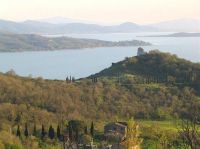Umbria, Italy
For tourists and Italians alike, the province of Umbria, Italy has always been somewhat overshadowed by its famous northern neighbour, Tuscany, and by Rome to the south. Tuscany has Florence, Sienna, Lucca and Pisa, while Umbria has the smaller but fascinating towns of Orvieto and Perugia as well as Assisi, Spello and Spoleto, among a host of other charming towns and villages. Perugia, in particular is a major Renaissance art city, and Orvieto is the home of one of the most dramatically beautiful cathedrals in the word, as well as being itself spectacularly located on a tufa plateau high above the surrounding Umbrian countryside.
Umbria, Italy, like Tuscany, is hilly - even mountainous - and green, with large areas of forest including quite large stands of cypress. Umbria is also home to Lake Trasimeno, the largest lake in peninsular Italy. Umbria is traversed by the Via Flaminia which, together with the proximity of Rome itself, means that there are many more Roman remains in Umbria than there are in Tuscany. This variety of terrain and history makes Umbria wonderful motoring country.
More about the university town of Perugia
More about Orvieto and its splendid cathedral
 | Lake Trasimeno is the fourth largest lake in Italy, being slightly smaller than Lake Como but nowhere near as deep. Lake Trasimeno has three islands, Isola Polvese, the largest, Isola Maggiore, which is inhabited, and the smallest, Minore, which is a bird sanctuary. Towns around the periphery include Passignano, Monte del Lago and Castiglione del Lago all of which remained virtually intact through the centuries. The shores of Lake Trasimeno are for the most part dense with reeds that are the home to a wide range of bird-life. A drive around the lake makes an excellent one day excursion. There are fine views of the lake from as far away as Cortona, Italy.
More about Lago Trasimeno Lake Trasimene.
|
|
|


